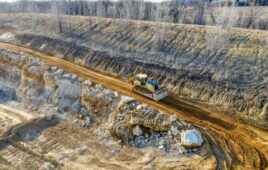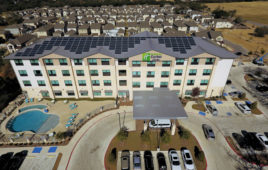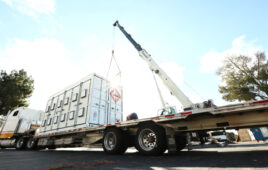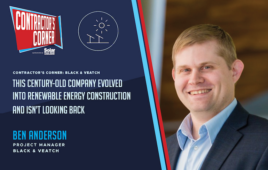In this special edition of Contractor’s Corner, we speak to commercial and residential solar contractor Motive Energy about the process of integrating solar construction services at a company level. Eli Edwards, general manager of Motive Energy, breaks down the process of adding solar construction and lays out how the company handles PV installation with new customers.
Below is a portion of the company’s Solar Spotlight podcast with Solar Power World, but be sure to listen to the full episode here or on your favorite podcast app.
If you’re a non-solar contractor with customers looking to add solar, where do you start to bring that scope into your company?
I think for any contractor that’s working with customers, your No. 1 goal is to bring value to your customers, trying to either add scope that’s going to benefit their business, or make their life better or easier. Most contractors when their customers approach them to do either solar — or they’re thinking about adding solar to a project — the big questions that come up right out of the gate are, how much is it going to be? And how much room is it going to take? A lot of customers when they first get exposed to a solar project, they have ideas of what it’s going to cost or that it’s going to take up their whole parking lot or every ounce of building weight that they can possibly manage to put on the roof and it’s going to be a lot of problems and issues. When in reality it’s usually a really simple process that the customer gets to enjoy.
We like to start with customers just talking about the value add of solar, making sure that they understand that each system, whether it’s on their roof and helps to offset power from the sun’s rays beating down on the roof, or whether that’s carports in their parking lot that gives their employees additional shade on their cars during the day — there’s value to it, let alone the fact that hopefully our main goal of saving the customer money against their utility bill. We like to have the contractors and the people working with customers focus on the positives and working through those and creating a realistic view for their customer, going through each step that leads to that project.
What are the steps needed to add solar to a project?
We’re starting with the customer, doing a site walk. We go out to the facility. We typically need nothing more than 30 minutes, maybe 45 minutes, for a regular facility. We’ll take some pictures of the electrical room. You need to understand how the switchgear and the interconnections are going to work. If it’s a greenfield facility or it’s not up and running yet, we need plans and we can work off of plans. But we need to understand where we’re going to interconnect that solar back to the facility. Taking pictures and some measurements in the parking lots or on the roofs to see where we’re going to place solar. Then we go back to our offices, we then develop a layout. So we have software that we’ve integrated with our projects that takes accurate measurements of the site, accurate measurements of modules and designs, puts it all together and we can create a model that represents how much the sun is going to affect those modules, how much production is going to come out of those solar modules and then how much of those modules is going to be pushed back to the grid or consumed by the customer.
We create an estimate based on the production of the sun to the solar panel. We put a cost together based on our experience in the industry. We’ve been around since 2007, so we’ve been doing this for quite a while now. We take our cost estimates, we build out a proposal and then are able to supply that to the customer. Once they have the proposal they can make tweaks, adjustments, which some customers might want to do more carports on a roof or on a parking lot or more solar panels on a roof to shave costs. So we’re able to go back and forth a little bit, working with them to develop that.
What types of suppliers and contractors are needed to add solar to a project?
It takes an army to do these kinds of jobs. We often say in the solar space, “It’s not rocket science.” If you look at it in a simplistic scale, you’re taking some solar panels, some glass and silicon, and you’re running some sun through it. There’s a DC wire to an AC inverter and back to a switchgear. For most contractors in the industry, that’s not anything difficult. Where it gets really tough on the solar side is we do most things backwards. The amount of personnel and expertise is more than most people would expect going into it. We bring in developers on our staff to design it and get it engineered. We’re a general contractor or EPC (engineer, procure, construct), utility coordinators, people to work with the utility to make sure that the way we’re designing the system complies with the way they’re willing to receive it. Each utility in California, Nevada, Arizona, Massachusetts, wherever, has completely unique sets of guidelines and you need to make sure when you’re pushing power to the grid you’re following those guidelines.
What are the biggest challenges most people face in building out a solar project?
The big challenge that most people face in solar projects is the fact that solar projects are built backwards. In most cases, when you’re designing a system or pricing a system or whatever, the customer goes to an architect or a designer and they design a system and then it gets engineered and all the details are put together. Materials to be used, square footage, the whole project is designed and it’s sent out for bidding to get built. In solar, we go in ourselves. The customer doesn’t have an architect or an engineer or anyone.
That’s one of the biggest challenges contractors and solar EPCs face is coming up with accurate designs and cost that can carry through a project without having to introduce any change orders or remedies to customers. That’s a big part of it.
Moving away from challenges and obstacles, where have you found success as a partner to your customers?
The first statement I made as any vendor or service provider, our goal is first and foremost to provide our customer with a product that saves them money, adds value to their business, makes their lives easier. Those are really important aspects as you hopefully are trying to build customers for repeat business and overall good rapport and holding each other accountable. One of the biggest key metrics for us to be successful, and therefore make our customers successful in the contracts and projects that we work on, is counting on the people we work with. Each project we do, because it’s a little bit different, you need dynamic partners. You need people that can take a challenge, have the engineering expertise or the construction expertise and work through the challenges that come up.
This podcast is sponsored by the Nucor Corporation






Your carport solution in your article looked quite elegant. I find that there is a serious dearth of architectural, well-designed, standardized carport solutions. EV charging integrated Solar carports is the cheapest & fastest way to avoid the $100b T&D infrastructure upgrade required to expand capacity to meet the EV charging load that will come from California EV/ ZEV mandate. Also, it’s the only way to ensure that the energy for EV charging is coming from renewable sources, not from gas-fired power plants.